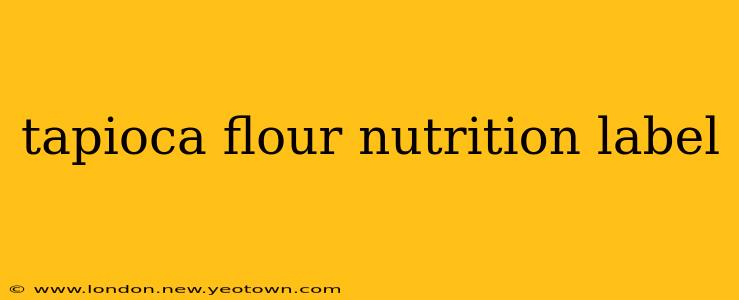Decoding the Tapioca Flour Nutrition Label: A Deep Dive into This Popular Ingredient
Tapioca flour, also known as tapioca starch, has quietly become a staple in many kitchens. Its versatility shines through in everything from gluten-free baking to thickening sauces, but what exactly is in this seemingly simple ingredient? Let's unpack the typical tapioca flour nutrition label and explore what it means for your diet.
Imagine this: You're standing in the grocery store, a bag of tapioca flour in your hand, and the nutrition label seems a little… cryptic. This isn't just some exotic ingredient; understanding its nutritional profile can help you make informed choices about your health and culinary creations.
What's Typically on a Tapioca Flour Nutrition Label?
A standard tapioca flour nutrition label will typically showcase the following:
- Serving Size: This will vary depending on the brand, but it's usually measured in tablespoons or ounces. Pay close attention to this as it dictates all the other values on the label.
- Calories: Relatively low in calories, tapioca flour usually provides around 100-120 calories per serving. This makes it attractive for those watching their weight, but remember, calorie intake depends on your portion size and overall diet.
- Total Fat: Minimal to negligible fat content, making it a great option for low-fat cooking.
- Sodium: Usually very low in sodium unless it's been processed with added salt.
- Total Carbohydrate: This will be the highest value on the label. Tapioca flour is primarily carbohydrates, largely in the form of starch.
- Dietary Fiber: Tapioca flour is low in fiber, which is something to keep in mind if you are focusing on increasing your fiber intake.
- Total Sugars: While it doesn't contain added sugar, the carbohydrates in tapioca flour break down into sugar during digestion.
- Protein: Tapioca flour provides very little protein. It's not a significant source of this essential macronutrient.
Is Tapioca Flour Gluten-Free?
Yes, tapioca flour is naturally gluten-free. This makes it a popular choice for individuals with celiac disease or gluten sensitivities, allowing them to enjoy baked goods and other dishes that would otherwise be off-limits. However, always check the label to ensure there's no cross-contamination during processing.
What are the Glycemic Index and Glycemic Load of Tapioca Flour?
The glycemic index (GI) and glycemic load (GL) are important factors to consider for those managing blood sugar levels. Tapioca flour has a high GI, meaning it can cause a rapid spike in blood glucose. Its GL also tends to be relatively high, especially in larger servings. While suitable for some, individuals with diabetes or insulin resistance should consume it in moderation and as part of a balanced meal.
How Does Tapioca Flour Compare to Other Flours?
Tapioca flour differs significantly from other flours like wheat flour, almond flour, or coconut flour. It has a neutral flavor and a light texture, making it ideal for certain applications but less suitable for others. Its low protein and fiber content mean it won't produce the same structure or chewiness as wheat flour in bread, for example. However, its ability to thicken liquids makes it a great choice for sauces and puddings.
Can Tapioca Flour be Part of a Healthy Diet?
Tapioca flour can be part of a healthy diet, but it's crucial to consume it mindfully. Its low fiber and high GI content mean it shouldn't be the cornerstone of your diet. Incorporate it as an occasional ingredient, rather than a daily staple, and balance it with foods rich in fiber, protein, and other essential nutrients.
In conclusion, understanding the details of a tapioca flour nutrition label empowers you to make informed choices about your food. Remember, moderation is key, and a balanced diet remains paramount for overall health and well-being. Don’t let this seemingly simple ingredient be a mystery; embrace the knowledge and enjoy its culinary potential responsibly.

